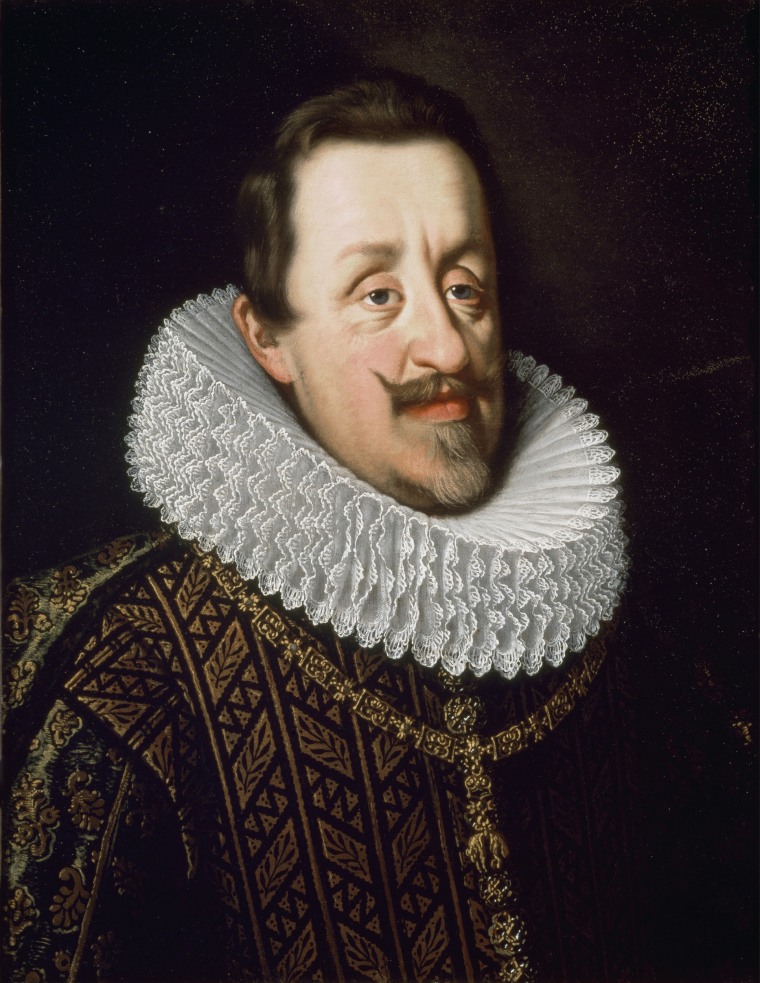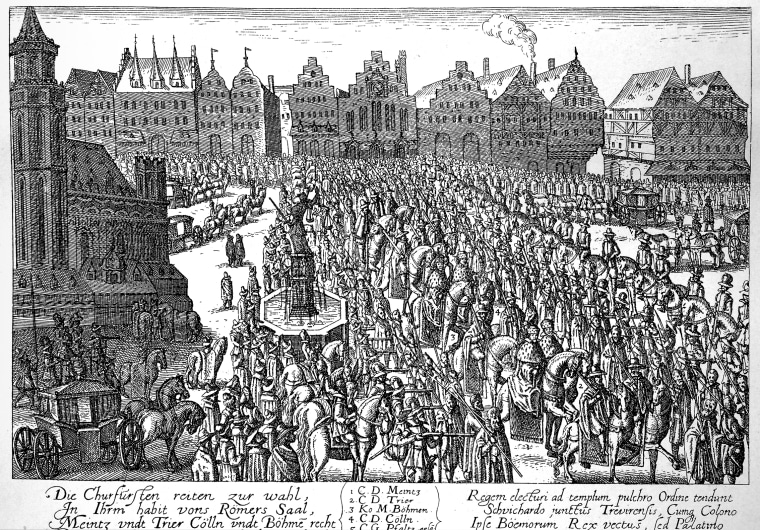Monday is the 400th anniversary of one of the most important events you’ve probably never heard of. On Sept. 9, 1619, King Ferdinand of Hungary, Bohemia and Croatia was crowned Holy Roman Emperor. It made him the most powerful monarch in Europe, ruling over parts of modern-day France, Italy, Germany, Poland, Austria, Switzerland, Slovenia and the Czech Republic as the supposed successor to the Western Roman emperors.
Ferdinand II’s coronation turned the Thirty Years’ War (1618-48), until then a series of armed scuffles between rival aristocrats and their militias, often over local issues (in one notorious incident, two royal governors and their secretary were thrown out of a window in Prague Castle), into a full-scale military conflict pitting Catholicism against Protestantism and the Holy Roman Empire against those that sought to end its rule. It ravaged Europe and left some 8 million people dead; in parts of the continent, half the population was killed or starved to death as marauding troops destroyed crops and stole food supplies.
The effects of this devastating yet near-forgotten conflict are still reverberating through history.
The effects of this devastating yet near-forgotten conflict are still reverberating through history: Religious emigres fled to the United States; the Vatican was forced to ease its restrictions on scientists such as Galileo; France and the Netherlands became world powers; Germany’s route to nationhood was blocked, eventually leading to the World Wars. And the bloodshed eventually gave way to a peace treaty that enshrined religious self-determination and a measure of tolerance while creating the twin pillars that still govern diplomatic affairs — the sovereignty of the nation-state and the concept of international law.
Some of these legacies are particularly relevant today, so it’s worth asking, what are the lessons for us in Ferdinand II’s reign during the Thirty Years’ War?
The first lesson is that war rarely goes as expected — even in triumph. Ferdinand won a swift victory early on in his military campaign, which was chiefly motivated by a desire to crush his rival, King Frederick V, just elected King of Bohemia following Ferdinand’s accession to emperor. In less than two hours, Ferdinand recovered the throne of Bohemia, part of the modern-day Czech Republic, and pushed Frederick into exile.

But Ferdinand’s new dominance in central Europe alarmed Denmark and Sweden, and these two northern powers eventually came to fight against him; this, in turn, created opportunities for France and the Netherlands, leading them to muscle in and make easy winnings against an exhausted opponent. Somehow, Ferdinand’s battlefield success made his problems larger, not smaller. It remains true today that the real outcomes of wars are very hard to anticipate; unintended consequences — both good and bad — can easily dwarf the impact of an immediate victory or defeat, so one should never celebrate too quickly.
Second, leaders can’t restore the past. Throughout the 1620s, as Emperor Ferdinand II’s tough new military chief, General Albrecht von Wallenstein, won victories against foes great and small, and expanded the rule of the Holy Roman Empire into Protestant northern Germany and much of Denmark, Ferdinand ordered that Catholicism be forcefully re-established — including in places that had been Protestant for a century. People were encouraged to convert, while those who held out could face harsh punishments. This culminated in a 1629 edict that sought to return to Catholic ownership lands acquired by Protestant families from 1550s onward.
Ferdinand’s edict caused chaos and great resentment, and proved hard to enforce. Three-quarters of a century since the end of World War II left Moscow dominating half of Europe, Ferdinand’s efforts remind us that it is neither wise nor practical to try to re-establish a system from 70-plus years earlier without acknowledging the changes that have occurred since.
Third, soft power — influencing others by offering an attractive vision of something appealing rather than using force — can win out over tyranny. Ferdinand’s bid to enforce an absolutist rule in the lands he conquered generally failed (although he did consolidate his power in much of Bohemia) because he didn’t have enough control over both events and how news of them was conveyed. Many of his efforts to demonstrate toughness backfired: The very public execution of 27 rebel leaders in Prague in 1621, for example, became a cause célèbre that rallied his opponents. Even now, the 27 are celebrated as martyrs.
Dispensing soft power, maintaining the moral high ground and projecting a strong message are vitally important today.
For centuries afterward, technology and the means of communication became sufficiently centralized — what was conveyed during Ferdinand’s time by rumor and town criers gave way to state-controlled broadcasters and newspapers — to make totalitarian rule viable in the 1930s. But our current era has seen media and innovation disperse decision-making again. Dispensing soft power, maintaining the moral high ground and projecting a strong message are vitally important today when confronting authoritarian adversaries.
Fourth, allies matter. Emperor Ferdinand won his first battles with help from a coalition called the Catholic League (a broad military alliance across Europe united against Protestantism) and his enemies lost while they were divided over petty squabbles. But Ferdinand faltered when his opponents formed alliances against him — first small principalities in Germany, then Denmark and Sweden, and later France.
SIGN UP FOR THE THINK WEEKLY NEWSLETTER HERE
He could have done more to ally with the peripheral actors in the conflict, such as Russia, England and the Ottoman Empire, but failed to. And he allowed the Catholic League to splinter apart. Without these alliances, he lacked not only military strength, but also the intellectual perspectives, political support and flank defenses they offered.
Fifth, sustainable peace involves compromise. Cognizant of his waning health and declining authority, and wanting to anoint his son as successor, Ferdinand II agreed to an initial peace deal in 1635, two years before he died. It contained a partial amnesty for his enemies and some freedom of religion for those within his empire.
The final Peace of Westphalia in 1648 enshrined the principle that sovereign states, or nation-states, would determine their own affairs, including their state religion, with citizens of different faiths given the right to worship in private. It also set down land boundaries that have come to define much of modern-day Europe, settled some border disputes and crystallized the idea that these nation-states were the preferred entities of governance.
Overall, and compared with other treaties of the time, the Peace of Westphalia proved an effective and durable arrangement. Parts of it are still with us today, for instance, in the United Nations Charter. The Rules Based International System — the fabric of economic and security arrangements, multilateral organizations, and codes of international behavior that underpins modern peace and prosperity — heralds from the accord.
Ferdinand II suffered greatly because he alienated those who could have supported him.
Inevitably, it involved compromises between once-irreconcilable foes. To some, including many of Ferdinand’s former associates, these were distasteful. But the Peace of Westphalia proved sustainable because those enemies were given an incentive to uphold it.
The Thirty Years’ War occurred when the relative might of a single, once all-dominant power and cultural hegemon was being challenged — the Holy Roman Empire and the brand of Christianity it promoted. Now the United States and its system of democracy, human rights and prosperity through the Western economic model faces a similar test.
Ferdinand II suffered greatly because he alienated those who could have supported him. Fortunately, the United States enjoys stronger and more durable alliances than Emperor Ferdinand, many of which came to the country’s aid after 9/11. But it remains important that they are prized and understood, not undervalued. While many of the significant consequences of Ferdinand II’s rule go unrecognized, on the 400th anniversary of his coronation, it is worth recalling them — and the powerful lessons they provide us today.


